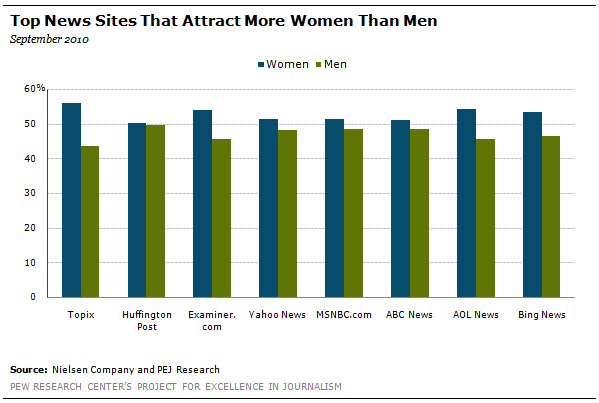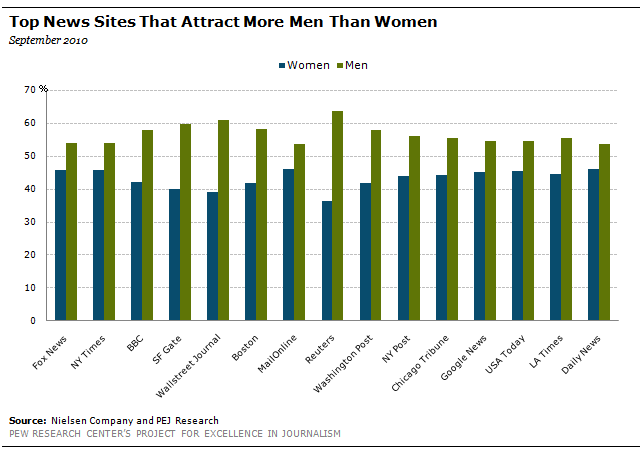The NetView data does not breakdown the behavior patterns like time spent or return visits for the various demographic groups. It would be interesting to know, for example, if women tended to return more times over the course of a month or if younger cohorts stayed a shorter amount of time than their older counter-parts. Nevertheless, at the more summary level, some interesting differences emerge among the top 25 sites when compared with Internet users overall. [1]

The most striking differences occur in gender. While usage of the Internet overall is roughly equal among men and women, [2] this is not the case for the top news sites. Some of the top news sites clearly appeal more to men while others attract more women. On eight of the top 25, sites women outweigh men and on four of the sites by more than five percentage points. On the 17 other sites, the reverse is true.
One split occurs in the Websites that offer their users a host of services. AOLNews.com, YahooNews.com and BingNews.com draw a heavier female audience while more men turn more to Google News. On Google News, men outweigh women by 10 percentage points, 55% to 45%. But at Aolnews.com the reverse is true, 54% women to 45% men. YahooNews.com, another multi-service provider, is more evenly split but attracts more women (51%) than men (48%) as does Microsoft’s search engine BingNews.com.
Women also flock in greater percentages to the two largest local news aggregators, the Examiner.com and Topix.
Men, on the other hand, tend to dominate the business-oriented news sites on the list. The starkest difference is on Reuters.com, which has nearly twice the percent of men as women, 64% versus just 36% for women. Similarly, on the Wall Street Journal (WSJ.com) and SFGate.com men outnumber women, 60 to 40%.

What about age?
Huffingtonpost.com had the greatest proportion of younger adults (18- to 34-year-olds. Fully a third (32%) of its users fell in that group. Google News brought in the greatest portion of the very young, 2-to-11 year-olds. The site with the oldest cohort was FoxNews.com, with 15% of its audience over the age of 65.
Overall, the audiences to these top news sites break down fairly similarly to Internet users overall.
That stands in contrast to news consumption patterns in older legacy media platforms like network tv, where news consumption tends to skew heavily toward older Americans. This might bode well for the future of news.
Online news consumers also tend to make a good deal more money and be slightly more educated than online consumers overall. Roughly 40% of online users in general make more than $50,000 per year. For news sites, the range is much higher with between 60% and 80% of the audience making more than $50,000 per year.
Education fits a similar pattern with online news users tending to be more educated than Internet users overall. On the top news sites, those with a bachelor’s degree make up between 25% and 29% of the audience, compared with roughly 21% of general Internet users.
Income
- The largest percentage of the audience across all the sites makes between $50,000 and $75,000 per year.
- The largest variance occurred in the highest income bracket – those that make more than $150,000 per year. At the high end was the Wall Street Journal (WSJ.com) (13% in this income bracket) and at the low end was Topix.com (6%).
- On 21 of the top 25 sites, the lowest income bracket, those who make up to $25,000 per year, made up between four and eight percent of the audience. The Wall Street Journal and Reuters.com had the lowest portion of their audience in this income bracket, 4.7% and 5.3% respectively. Topix.com and YahooNews.com had the highest portion; 11% of Topix audience was in this bracket and 10% of Yahoo’s.
Education
- The largest portion of visitors to the top 25 sites had bachelor’s degree, ranging between 25% and 29% of the audience. The next largest portion of audience is those with some college, ranging between 24% and 27%.
- The largest variance occurs with users that have post-graduate degrees. At the high end was The Wall Street Journal (WSJ.com) at 27%. NYTimes.com, BBC.co.uk, Boston.com and SFGate.com were very similar with 26% each. Topix.com had that least amount of users with post-graduate degrees, 11%.
FOOTNOTES:
1.The demographic data analyzed here are from Nielsen’s NetView database from September 2010 and are derived from the same panels that are used to gather audience data.
2. Pew Internet & American Life Project, “Demographics of Internet users,” May, 2010.


